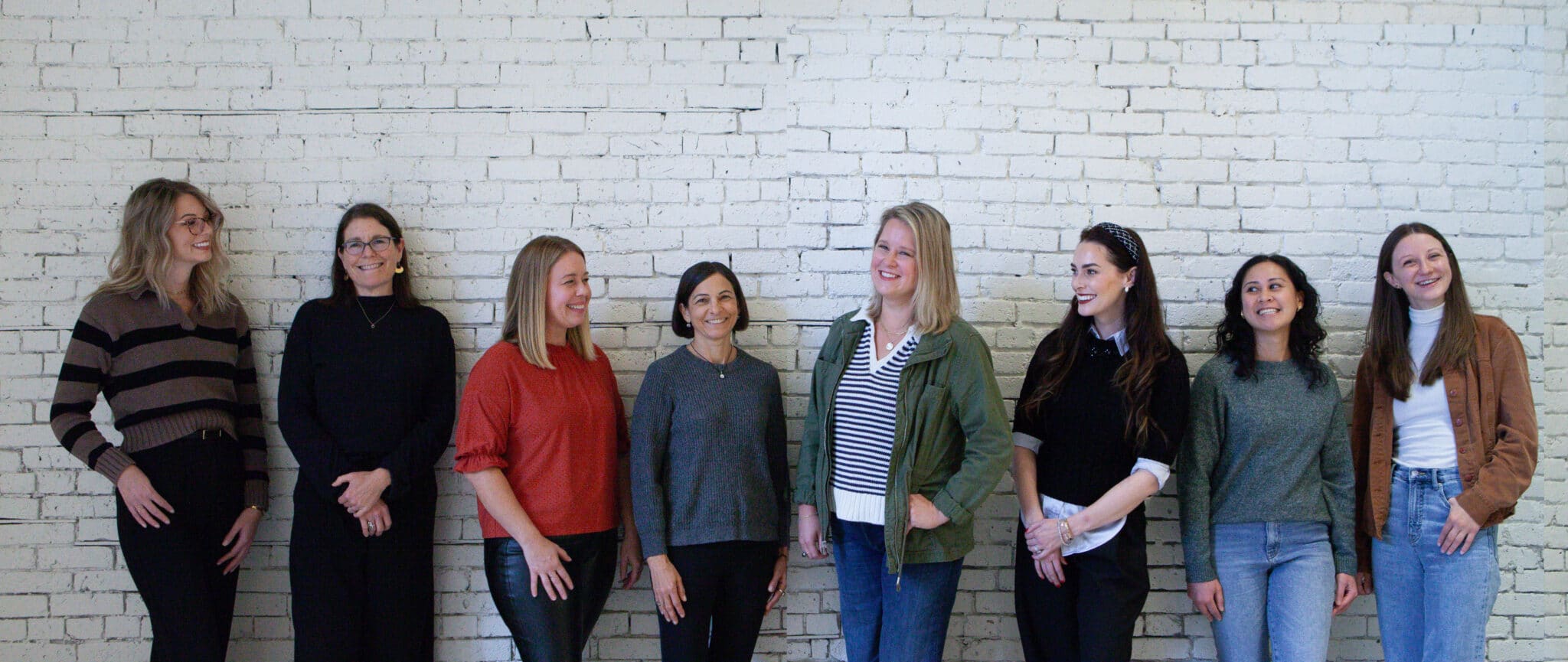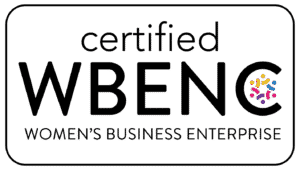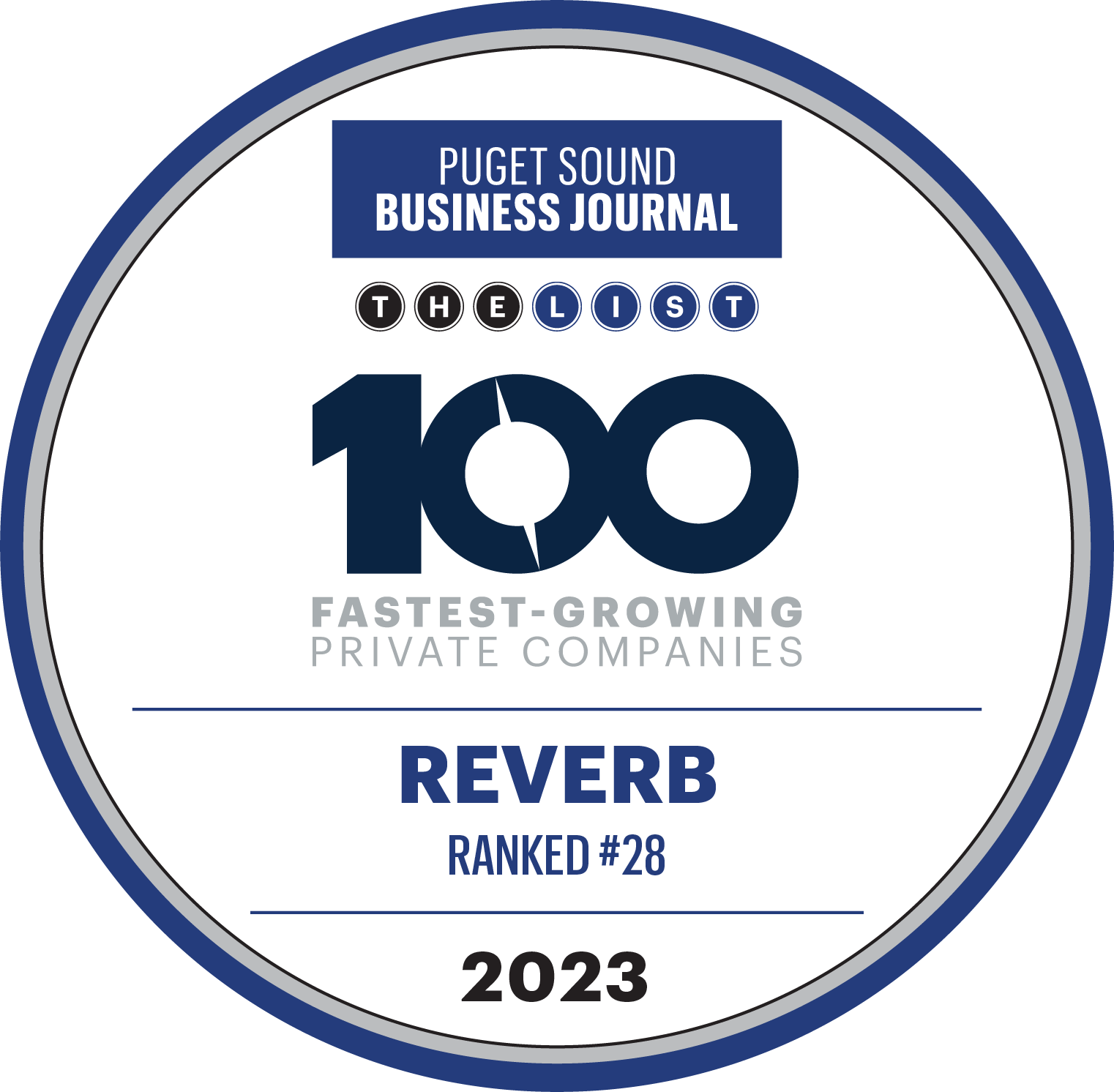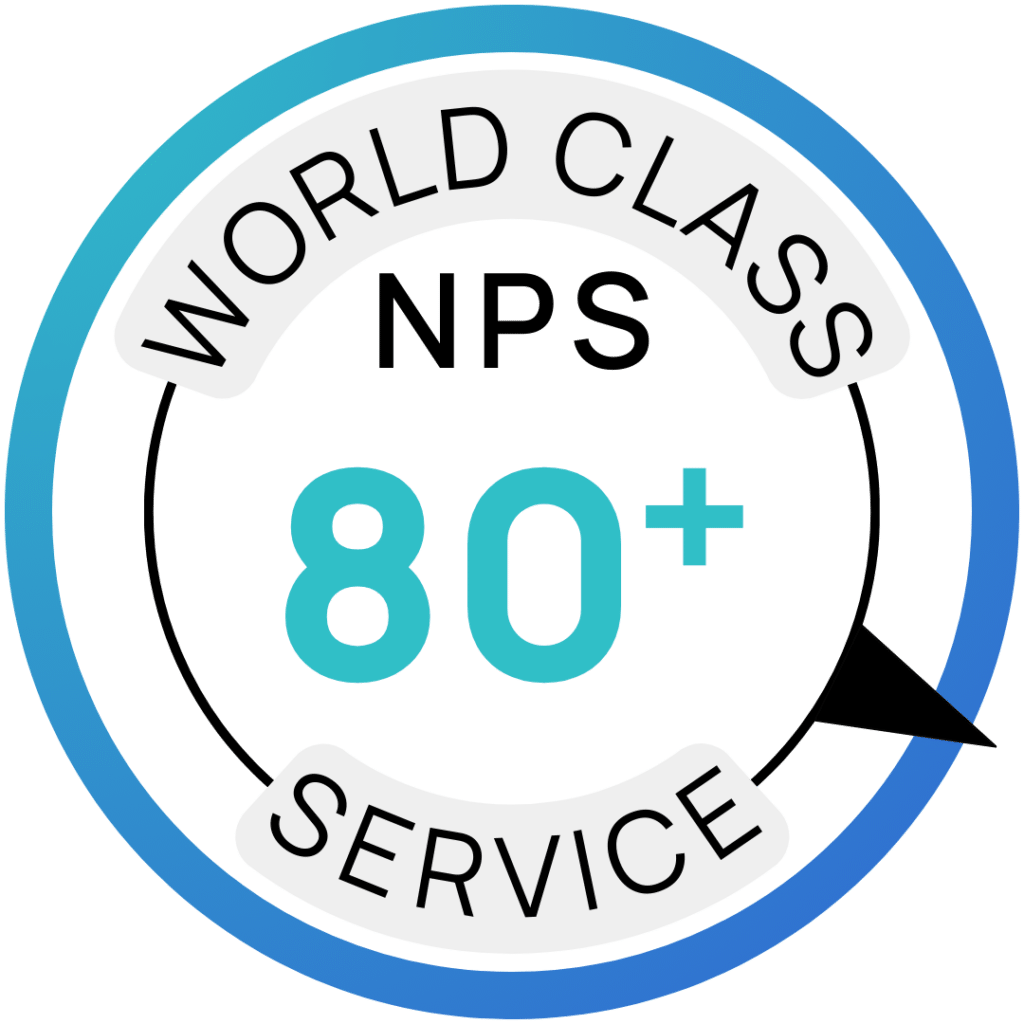The following is a transcript of our podcast conversation with Sarah Wilkins, Rebecca Barton, Kristy Burke, and Shauna Chernicoff. You can listen to the full episode on Spotify or Apple Podcasts.
Sarah Wilkins
Hello and welcome to Humans Beyond Resources, an HR podcast by Reverb where we cover topics from culture to compliance. Reverb believes that every decision a leader makes reverberates throughout the organization, from hiring your first employee to training your entire workforce. We believe in building healthy, inclusive cultures that engage your team. I’m your host, Sarah Wilkins. Thank you to our Humans Beyond Resources podcast sponsors, Parker Smith & Feek, AHT, and Joshua Brittingham of Carney, Baidley & Spelman.
Rebecca Barton
My name is Rebecca Barton and I work with Reverb and have been a practice director here for a few years, working mainly on our people operations service and have the pleasure of getting to work with these lovely people, Christy Burke and Sean and Sharon, who are consultants on the team and who are here today to talk with me about return to office and all of the complexities, ins and outs, challenges, pros and cons, and some hopefully creative solutions for y ‘all to think about and consider and take back as you either introduce this or change it, morph it into something different as time goes on and talking to your teams about it. I went to kind of look at some stats just to sort of just give some context. And I think 50, 50, right. I think some people really enjoy being in office. Some people want to be fully remote and some people want a mix of all of it. So I just saw a Gallup poll around this topic. And like, as of December, 2023, 38 % of organizations are requiring in person. And that
Rebecca Barton
was down from almost 50 % at the beginning of the year. So some changes there. 20 % of remote -capable employees work fully on -site, so a very significant amount of the population is working hybrid. I think that’s probably the winning model, and about 30 % of professionals are fully remote. And I just want to emphasize or say the privilege of being able to get to work in a hybrid or remote setting and understand a lot of positions and types of workplaces. people have to be fully in person. So just want to say that. But yeah, so just to kind of get started in the conversation with Shauna and Kristy, I would love to if if you have a story or an experience from a personal or professional time that you would want to share just to highlight interaction you’ve had with this topic as we start to go through it.
Kristy Burke
I love this topic, I will tell you and personally and professionally like love it, hate it kind of thing professionally a little bit, but personally, I will just say that if you would have asked me five years ago, if I could do a job in human resources remotely, I would never have said yes. And so it’s been a huge learning curve for me just personally that, wow, this does work. And professionally as a consultant, I’ve had the opportunity to work at different places and see how different companies are doing different things. And that’s been super interesting. And I think the, the biggest This aha for me is making sure that you have a why, because there are going to be people that are like me, that are really loving working from home and can do it and feel like, you know, what am I missing? And so being able to articulate that, particularly if there’s a mandate to come back into the office, I think that’s super important.
Rebecca Barton
And I think we’ll talk about that a little bit further, but I’m curious when you were like, oh my gosh, before I never ever would have thought this was possible, like what What did you start to experience or how did you feel that impact for you? And you’re like, oh, this does this does kind of work for me.
Kristy Burke
I like for me, I bonded with people just over Zoom that I didn’t I just didn’t I hadn’t done it. And so I thought I would need to be in person to have like real heart to heart conversations and really get, you know, connect with people. And I I just recently I was working with a leader for six months and we just met for lunch for the very first time. And it was like, I feel like it was weird because I felt like I had known her this whole time, but I had actually never met her in real life. So I think because HR, so the connection is so important. I just, you wouldn’t have been able to convince me unless I lived it, that it was possible.
Rebecca Barton
Yeah, definitely COVID was a forcing function for sure. Shauna, how about you?
Shauna Chernicoff
Yeah. So I like how you broke that up into professional and personal. So, um, on a, I guess, semi personal and professional note. So first started like this notion and like thinking about hybrid work about 10 years ago when I came back to work after being out on parental leave. And it was really interesting because nobody was really doing it at the company that I was working for, but it was something that I really advocated for myself that I thought I really needed to kind of have that flexibility and being able to show up at home and at work my best, you know, best possible self. And so I’ve been really curious and like have a lot of thoughts and experiences on the hybrid workplace. and how that’s evolved over the last 10 years, but especially in the last few years where it’s become more front of mind and more companies and more folks are moving to that model. So I’m super interested to share my experiences that I’ve had with working hybrid and some things that really worked and some things that didn’t work so well, but also to learn from other people about what experience that you have had and where is it working better than other places and how might we go about thinking about either implementing it, requiring it, all those different topics. But yeah, so professionally, like an experience, Rebecca, you’re familiar with this one, the last company that I worked for, I joined in September of 2020. So kind of like the peak of COVID where everybody was fully remote for the most part. And I worked there for nearly eight months before I met the CEO and the COO who I reported to. And so that was like a very interesting, like funny stories, like walking in the first day and you see somebody on Zoom and I walked in, And he was like almost seven feet tall. And I had no idea because I had had all these conversations with him, but had never seen him in person. So it’s like, you totally do have these bonds that you can make with people over a Zoom, but it is nice sometimes to have those in -person connections.
Rebecca Barton
Yeah, I feel like the Zoom thing, it’s kind of forces to have certain kinds of conversations or share things. And I think, you know, sometimes it’s, it just really creates some different openings to connect. So thanks for that. And that’s amazing to hear that you’ve kind of been, you know, spearheading and thinking about this in terms of how it can be, like you said, bring your best self and be present for home and family and also at work. So I think that’s, I mean, at the end of the day, that’s really what it’s all about. And I know there’s just been a lot in the news recently or in the past year or two about returned office. And I know some people might be like, well, this is kind of a topic that’s kind of, yep, talked about it. But I do think as things evolve And as the economy changes and the talent pools changes, it’s still an issue and I think a lot of companies are still really navigating it. So I think it’s important to keep it top of mind. I’m curious what you both think and what you would say about, I know a lot of companies either mandating a few days in the office or fully coming back and the decisions already been made, right? And as HR leaders and working with these groups and trying to be the strategic influencer and help, you know, the majority. So what, what are some things that you would say people either you have, or you would suggest that people leaders help when you have that kind of constraint or like a decision’s already been made. What are some ways leaders can help with, you know, the change management and, or influencing, um, and bringing forward some considerations. For, for making it happen.
Shauna Chernicoff
Yeah. I mean, I’ll, I’ll take that one. Just, I think that if it’s a decision that can’t be walked back, it’s, it’s been, it’s been made and there’s no, there’s no turning back. I think there’s a couple of things to consider. And one is like communication. I mean, employees, like, uh, we, because you just mentioned like people want to know why. So if you’re going to implement something like that and just say like heavy handed, this is what it is. You really have to understand that people want to understand the why behind it. So I figuring out some way to navigate that piece and communicate it effectively, I think is really important because you’re going to get the questions like, where is the data behind it? Why now? What is, what is the reasoning for three days versus two days? whatever that might be. And I think that’s a really big piece. And then I think the second piece for me is designing it. If you have people coming in every day and they’re just sitting in meeting rooms on Zoom meetings with people that are working remotely, it’s going to make people resentful and it’s just a waste of people’s time to do that if the whole notion is that we need to be in person together to collaborate. I think there’s a key design aspect to it to ensuring that it’s a good use of collaboration time if you’re mandating that. And have those points,
Rebecca Barton
Cause those are very, I think, valid and important points like been part of the conversation and something the leaders have been willing to discuss in any situation that you’ve been in where there’s been a discussion about return to work and, and sort of weighing the pros and cons.
Shauna Chernicoff
Yeah. I think in a previous company, I think that the biggest thing was the design piece for us that the decision had been made and had actually been walked back some already based on employee feedback. So I was glad that the leaders along with, you know, myself were able to take that feedback and to like, we were really letting people vote with their feet a little bit. So we were counting badge swipes, but not in a negative or punitive way. We were doing it to really see like who’s going in, when are they going in and why, and then using that data to kind of make our policy and then trying to use some design methodology to understand like which teams are coming in on which days are those are the teams that are collaborating, collaborating just with their internal team. And then when you’re looking at like cross -functional data between which groups
Rebecca Barton
are working together. I love the concept of the design, like you design any policy, right? I think it’s just important to think about all the factors. Hey, Christy, what do you, any, any thoughts from your experience on your side that you want to add?
Kristy Burke
Yeah, I think a couple of things. I think one is giving advanced knowledge to people that this is coming because there are, and acknowledging that this is this could be a huge adjustment, not just like personally, but like family and life and just like coordination of child care and all the things that may need to shift. And so giving that notice as soon as possible and then having some flexibility while it’s ramping in to whatever the decision is. And then the other is really taking the time to prepare the managers because they’re going to be the front lines of this working or not. You want them to A, be consistent with their teams, and then also be able to answer some of the more expected common questions and pushback that they might get from their folks.
Rebecca Barton
Yeah, I think those are all really important points. And the flexibility and having some different options or choices, and it’s not a one -size -fits -all experience necessarily. And sometimes that’s good and bad. Some people see other people getting treated seem like it’s perceived to be getting treated differently, any thoughts around that and just how to manage the optics and especially if it’s like, Oh, there’s certain like group of people who are highly paid and get to keep doing that. And then there’s other folks, you know, more middle or lower, lower on the totem pole employees don’t get that benefit, but you had to handle it.
Kristy Burke
That is lived that in the company I was with during the COVID times, there was a group of manufacturing folks that had to come in every day, regardless. And that in like comparison to the, all the, you know, white collar folks, the, the in office folks that, that were able to work from home and it caused huge us against them, you know, the haves that have nots. And that was, that was really hard to navigate. And I don’t know that have an answer of how to solve that other than again, like having communicating and explaining the why obviously manufacturing, you need to be there, but trying to avoid as much as possible the like us versus them. And the, the other thing is have, you know, the having a process for exceptions or accommodations for, for people that either need more time or, but being consistent with that. So I’m at a company right now consulting and they have another consultant who’s pretty much full -time just dealing with like the requests for accommodations related to returning to the office, preparing for the work that’s going to come to be with just managing the process of getting people back and the people that don’t want to.
Rebecca Barton
Yeah. So that’s an important thing to think about once the program’s installed and just how to manage and receive requests. Is there anything about that process that you can share, a particular group or things about it that work really well or that would be worthwhile for the team?
Kristy Burke
I mean, this is pretty simplistic, but I just having a process, having a place where people can go to request, we call it a combination there, but, and, and then having some guidelines around what would constitute a reason to, to have this and then being consistent.
Rebecca Barton
Yeah. Yeah. You mentioned how important it is for managers around the training. Where have you seen that be effective in terms of like, how you, is it with, you know, onboarding with the manager or the employee, or where do you see it, I guess, making an impact when either bringing new people on or getting managers up to speed?
Shauna Chernicoff
Well, I just, I kind of echo, it goes back to what Kristy was just saying around having a process and a guideline. I think once that’s established, training the managers on what that looks like, I agree, like flexibility is key. And that’s like what employees want right now, right? I think if COVID showed us anything that like, that’s the biggest thing for employees is having the flexibility to choose or make decisions when an emergency happens or their kid is sick or they’re the elderly parent that they’re taking care of needs to be taken to an appointment, just like having that flexibility. And so training your managers a little bit, like what normal, like flexibility looks like and what it looks like to like need an accommodation. So I think it starts with the root of having a guideline and a process and then training managers, what good, consistent behavior as a manager, it looks like when you’re, you’re looking at these different scenarios.
Rebecca Barton
Yeah, absolutely. The role location type. I mean, I know some, like there’s different criteria companies have used around distance from a headquarters or having hubs so that just try to make it as easy as possible for folks. One thing I wanted to go back to was you mentioned earlier around the design pieces, the communication and transparency and, you know, also I think role modeling. So having the leaders or people who are really the ones like gung ho and feel that this is a really important part of the culture, you know, any insights or just best practices that are things to consider around those things?
Kristy Burke
I think one piece, I think this is really important because you’re going to need those, like the role modeling and the, there are going to be people that are going to be the like up front and helping to, to shape the culture, but giving the managers a minute to feel their own feels first. And so, and that kind of goes back to the, to the manager training, but giving them really making sure that they feel comfortable and ready and then identifying who are the folks that like really are passionate about this and either have been doing it well, if this is already in process and learning from them and from each other, I think is super important. But, um, yeah, I think the, the leaders, if they are not coming in, you’re in big trouble because someone’s going to want to come in.
Shauna Chernicoff
Yeah. On the leadership piece, I would just say, you know, this isn’t just something that the CPO or whoever the people leader is to design. It’s really takes cross -functional collaboration of all leaders in an organization to make this work and to make it right. You as the people leader, you don’t know exactly what teams meet on which days and which days are important brainstorming or big thinking sessions or whatever it might be. Like you really have to get together to determine what that looks like to help that design aspect and ensure that again, it’s a good use of time. So I think it really is on a group of people to really help make it effective and like a good planning session for that. And then I would just say, again, I echo like if leaders aren’t coming in, you have like nothing to stand on. And at that point of view, if you can’t see the value in coming in, why would your employees see that? So I just echo that statement that if that’s the case, you probably have bigger problems to deal with underneath all of that.
Rebecca Barton
And understanding too, even leaders like, well, I travel all the time, or, oh, I have to be in 50 places at once, or it’s still, it’s like, well, even if someone can like see you or experience you being around them a little bit, it goes a long way, the action of that. Going back to the including others and thinking about designing or finding out what’s really important for the population, what are some ways you’ve seen, Shauna, what would you recommend people do around that?
Shauna Chernicoff
Yeah. I mean, a company, it wasn’t 100 % perfect because there is not, like you said, a way to make everybody perfectly happy in these scenarios, but one was just getting the team together and looking at what days do your teams have stand -ups? What days do your teams have cross -functional meetings? you know, do they have a bi -weekly with your product and engineering meet bi -weekly or whatever it might be. And like looking at those days to try and coordinate, okay, I don’t just want to say three days, you have to come in three days. It was like, we’d like you to come in 50 % of the time with the days being on, you know, specific dates. And this is the reason why. So like talking together about schedules and timing and, you know, it is, it makes it a little bit more challenging when you have teams that there’s so many people are around the globe, they’re not central to one city. So also like taking that into account, like, are we so distributed that bringing three people into an office on a team of 20 actually makes sense. And this is one of the things that I think about, like my past hybrid experiences, the experience as being a hybrid worker, being one of the few that’s, or one of the people that’s remote and how you actually feel if you have a bunch of people in person and how, um, you know, uninclusive it can actually feel, especially in the way that you design your meetings for when you have remote participants when there’s a large group in person. And so I think there’s also that aspect to take into account because I’ve, I’ve, I can go on a whole tangent about that, about the experience of being the only remote worker, but, um, yeah, there’s, there’s lots of things to think about in that regard too, if there’s, if the team is so dispersed, does it actually make sense to bring the majority of the team or bring some of the team in?
Rebecca Barton
Yeah. Yeah. That’s a great question just to like really think through it. And I also, I’m guessing that as you talk to groups about that, you help managers even like, oh, wow, I need to do like, I just need to do that anyways. Like just sort of a standard structuring how they might be communicating and interacting with groups.
Sarah Wilkins
So going back to the badge swipe thing. And Shauna, I know you were using it more as a way to design, but I know of places using it more of like an accountability feature and even then employees feeling stressed because they had to stay home a couple of days with their child that was sick, but that their manager was bringing it up to them that they weren’t coming on site like they were supposed to. And so, you know, that can feel very watching over the badge swipes, but there is the accountability aspect as well. When we do set these policies, right. And, and holding people accountable. So I’m curious, any thoughts y ‘all have on that? Because yeah, I know the badge swipe tracking doesn’t feel good from an employee perspective.
Shauna Chernicoff
Yeah. I mean, I would say this goes back to like manager training and utilizing your managers to know what their team is doing and where they are. And, um, yes, that’s still in a way feels like they’re being watched, but it’s less invasive, I think than using like, you know, bad swipe counts to, to notice that. Because I also think that’s where it also plays into like the flexibility. Like you said, my kid was sick and, but my manager knows I would have come in today, but, and so they have that, like the bigger context and the bigger picture there. So I think that’s important as part of the training too, and the flexibility piece
Kristy Burke
like something you said earlier, Shauna, was the helping managers to understand where they can make a call versus where they can’t and where that line is, I think is super important because yeah, there’s going to be situations where you’re not going to come in three, but that’s okay. But managers need, like I learned this through this process, the clarity that managers need on what they can and can’t approve or not is super important.
Rebecca Barton
The communication piece is just so, so important and the manager training has come up a lot. So it’s probably one of those kinds of policies or work environment things that just just requires that and still learning more about that. Yeah, I was just gonna kind of go into the accountability piece there. So you kind of read my mind because I feel like, and it’s also as people are kind of coming back into the workplace, so the accountability piece and then how to handle that and still maintain some flexibility. But then I’m kind of interested now in talking a little bit about how the return to office is impacting folks like who’ve never worked in an office before, like their new generation to the workforce. and they’ve also had school in COVID. So it’s like double whammy and how dealing with that. And then also just the pre -development collaboration side of it and the benefits around that.
Kristy Burke
On the people who have never worked in person, I think that is acknowledging that and understanding that I think is half the battle because it is an adjustment. And so there may be opportunities to really enhance and put a shine on like, what are some of the great things about being together? I don’t even if it’s, you know, having all hands meetings and whatnot to get people in and like comfortable with being around others and just getting used to it and just being acknowledging that it might be an adjustment that that’s really hard and being okay with, you know, letting it have a little bit of time to, to come to fruition and work. That is really fascinating and interesting because there are people that have never done it.
Shauna Chernicoff
Yeah. And it’s also interesting to think about what COVID in general did to people’s social, like emotional skills and how they’re able to connect with humans. And I have a, I have an almost 18 year old. So she’s has spent a lot of time, you know, doing school from home and whatnot. And she always talks about how her social battery is drained. And I don’t know if it’s like a, like a new kid terminology. I don’t know. But she talks about that often when she’s has to be like at school or in person, or even at family events sometimes when you’re around people so much. So I imagine that this like new workforce that is kind of in that same situation where they’ve just been behind a screen for so long. I think that in itself is a, an adjustment and having managers that have, you know, high, high EQ that are able to recognize where maybe somebody doesn’t feel comfortable or confident yet to say like, Hey, my social battery is drained. But, um, they might say show symptoms that maybe they are a little bit uncomfortable, but they just don’t know how to vocalize that. So having a manager that might be able to recognize that and like give them some time to work from home or whatever it might be.
Rebecca Barton
Yeah. Yeah, it’s such a, it becomes like this philosophical and more meta thing beyond just like, come on, it’s simple. Everyone just comes back. But it’s, you know, just thinking about the years of the impacts of the isolation and just that being able to go, like, go charge your batteries a little bit, but now not, you know, now you’ve got the commute, you’ve got to be in person, you’ve got to be, yeah, face to face. And that’s just a different, a different way of being. What I’ve noticed, or I don’t know if y ‘all have have seen this or have things to add on here, but just more emphasis on having some, you know, flexibility and just put some benefits or EAP or whatever else kind of mental health support, um, or ways of optional connections, um, or, or even if places have spaces that are quiet where you can like go meditate, or you can go take a nap or something like that.
I don’t know if you’ve seen things like that pop up. More around like the EAP and the wellness and like doing subscriptions to Headspace and things like that, more just like around like mental health in general, because I think that’s much more widely talked about in the workplace.
Sarah Wilkins
I’ve kind of gone through a lot of the questions that I had prepared. Is there, I mean, is there anything that like you, you want it like, oh, I really want to make sure people like walk away with this tidbit or just like something to think about or noodle on around like a challenge, benefit, just creative solution, anything else that is good for the group to hear?
Shauna Chernicoff
I mean, one thing that I think is just like something for employers to consider is that over the last, you know, four years, a lot of people, their, their lives have changed and they’ve taken on these additional roles while, you know, still being an employee at the company, like for instance, myself, we lost our before and after school care, which closed down during COVID and hasn’t reopened. So I am now the primary person has to take my kids to school and pick them up at three 25. And that additional, like carpool, if you will, role has added a lot of stress and makes it really challenging for me in terms of like working hours and, you know, dropping that, like dropping them off and still going into an office and only being there for five hours before I have to turn around and go pick them up. So there’s lots of people that are taking care of like parents that are sick. And there’s like all these other roles that people have taken on outside of work that I think really needs to be thought about before mandating people come in, because they do really have to change, like Kristy said, giving them that time to plan, because a lot of people’s lives have just changed so much. And it’s this new way of work actually works better for people to be able to accommodate all those things and not completely burn out. So I think it’s just important to understand that.
Kristy Burke
One thing that I’ve noticed, and I’m working with a company where they’ve hired fully remotely anywhere, right? And so now it’s, we’re going to return to the office, but people are all over and they may or may not have offices nearby. And so taking, this sounds simple too, but like taking an inventory of like, where are people and what, like what is the impact of this return to office mandate? Where are there going to be people that are still going to work remotely? And, and then also like slash, um, think about the requirement of how far someone has to live. Cause I want situation where it’s 50 miles. If you’re within 50 miles, you need to come into the office and that’s including San Francisco. And so also like just taking a minute to like really inspect, like, what is it that we’re working with here? and do these guidelines in the design really make sense and are they actually attainable?
Rebecca Barton
Yeah, that 40 miles could be two hour commute each way, right? In some places. I appreciate too and I’m excited this next generation and sort of that being more vocal and like advocacy for self and for others. I think that will continue to evolve and will help leaders see what people want and need and along with return to office or anything else that employers are providing. So just one thing that I don’t think we hit on too much, and we don’t do a lot of like, we’re not a recruiting agency, but I think like talent and retention and attrition, and those are very important things that we all look at with our clients and companies. So any, any thoughts or things you’re seeing around that?
Shauna Chernicoff
I think that, I mean, I still hear candidates asking about, you know, what, what is the work from home? What is the, what is the work model, you know, during the process, they want to see it clearly outlined in the job description, which I think that like the biggest thing as an employer, what you can do to set yourself up for success with new hires. And then also retention later down the line is to be super clear and transparent about your intentions right now. I think first step, obviously I just said it was the job descriptions, but then if you plan at some point and you know that you’re planning at some point to mandate some sort of percentage of time or days, you know, in the office that you’re clear about that upfront, because people are going to say, you know, and I’ve seen this time and time again, over the last few years, you told me that I was a remote position. And now you’re telling me I have to either relocate or start commuting, you know, you know, 50 miles to get into the office. And that wasn’t what I signed up for. And they will leave. I mean, they, again, they’re going to vote with their feet and then you have the cost of backfilling and training, and you’re probably going to pay more salary than you were paying before. I mean, it’s just all those things. Right. So I think it’s really important that you’re transparent with candidates because it’s still very front of mind for a lot of people.
Kristy Burke
Yeah, absolutely. I think it’s a huge incentive and particularly if you’re a company that maybe isn’t the highest paying. If you’re able to offer flexibility, that’s often a trade -off that is in the big picture, it means more.
Rebecca Barton
Time is very much part of the compensation picture that people are evaluating. So I think that’s a good thing to bring up to folks and you know, of course it’s competing priorities, right? Like, well, we have this 10 year lease or we have this amazing space. Like we get so much done here where everything started from, from this place. So I, I understand the conflict. Yeah.
Shauna Chernicoff
I think it just goes back to like the data piece though. Like, so how much more did you accomplish while you were in four walls? Then you have wherever your team is working right now. So again, I think it goes back to like, how do you quantify that and, you know, produce that data to give your why.
Rebecca Barton
Yeah. I saw some article with SpaceX, I think Apple and Microsoft or something and how So talent’s like kind of moving around based on flexibility for where they can live and work. So that’s, it’s a real thing. Experience some significant attrition with when they came back out with the return to office mandate of like three days a week.
Shauna Chernicoff
I mean, I will, I will say like, you know, it probably come off sound like I’m very like pro work from home, which is true for me, like really does benefit my life in such an amazing way. But I will also say like there’s days where I just, I haven’t talked to a human or like You know, for a whole week, I won’t really talk to humans. I’m like, my family comes home and I’m just like, blah, blah, blah, blah, blah. And like, Whoa, we’ve been out in the real world all day. But you’ve been in a computer screen. So there are like, there are downsides to working from home. It can be, it can feel really lonely. And I think sometimes I suffer from like my daughter syndrome where I go out and I, and then I’m like, Oh, I’m so overwhelmed after two hours of talking and like socializing in person. So I think there, I mean, there are like benefits to both sides, but I just wanted to be clear that like, it’s not a hundred percent wonderful always working from home either. I think that’s like something to take into consideration too.
Rebecca Barton
Absolutely. Thank you both, Kristy and Shauna for just adding so much like context and interesting ideas and just understanding of all the parts and pieces of this, this ongoing topic of return to work and just work in general. So thank you. Really appreciate it.
Sarah Wilkins
Thank you for listening to this episode of Humans Beyond Resources. Visit ReverbPeople .com to find free resources, subscribe to our newsletter, and connect with our team. If you haven’t already, subscribe to stay up to date on all of our upcoming episodes. We look forward to having you as part of our community.
Thank you again to our podcast sponsors. Parkersmith & Feek is a nationally recognized, privately held brokerage firm. They offer a full range of services, including employee benefits, commercial and personal insurance, and everything in between. The depth and breadth of their staff experience sets them apart as they provide stellar service and imaginative solutions for all clients. Joshua Brittingham of Kearney Bailey Spellman is a seasoned employment lawyer and he works with entrepreneurs and business leaders, especially in construction, hospitality, and financial services to help them handle sticky employee situations so they can thrive in a complex world. Joshua is also a professional speaker, panelist, and teacher on the topic of all things employment law. A .H .T. Insurance is an insurance, brokerage, and consulting firm offering property and casualty, employee benefits, retirement, private client, and international services for clients throughout the United States and 42 other countries. Supporting numerous industries and boasting national recognition in the technology, manufacturing, government contracting and non -profit practice areas AHT offers clients highly customized solutions to identify and help mitigate risks they may face.











